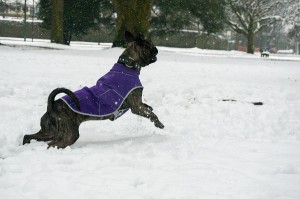Most of us enjoy dressing up our dogs, even if it’s just a shirt. Winter provides us with an “excuse” to dress our dogs up even more, because of the cold weather. But do dogs really need to wear winter clothes?
The answer is…
It Depends.
“When we started developing our line of all-weather dog jackets, Buggsly Black Label, we looked into whether jackets were a must have or a frou frou accessory,” says co-founder Cassidy Morgan. “Through the research that we did, we discovered that whether dogs need jackets or not is dependent on their breed and fur/hair type.”
Dr. Jules Benson, Petplan Pet Insurance’s Chief Veterinary Medical Officer and part-time practicing veterinarian, agrees. “Obviously, dogs with denser fur, whose breed originally hails from colder climates (e.g. Husky, Malamute, Spitz, Bernese Mountain Dog) will very rarely (if ever) need any type of outdoor clothing, while others with short or thin hair, like Chihuahuas or Greyhounds, will often benefit from extra insulation and can quickly become hypothermic without it. Larger dogs (e.g. mastiffs), and dogs with a more dense body-type (e.g. pitbulls) will retain heat more easily than delicately-framed (e.g. Greyhound) or small dogs (e.g. dachshund).”
Morgan notes that Dogs who are groomed regularly to prevent matting (such as Poodles) can also benefit from jackets.
“It is even possible for dogs with longer hair to need jackets, specifically in wetter climates to help keep them dry,” she says. “Wearing a jacket helps keep your dog warm, dry, and more comfortable overall.”
In addition, Dr. Benson says dog owners should be aware of their things like age and ailments that can affect whether or not their dog is comfortable outside.
“Dogs over the age of 7 can have weaker immune systems and winter wear could help keep them healthy throughout the cold-weather season,” Dr. Benson says. “Similarly, dogs with joint disease can benefit from keeping those joints warm while out in colder temperatures.”
What to Wear?

This age-old dilemma applies to pets too. If you have a dog that could benefit from winter clothing, you may now be wondering, what should she wear?
“Clothes – like a sweater or jacket – can help some dogs be more comfortable in winter weather,” Dr. Benson advises. “If you’re heading out for a long walk or notice that your dog is reluctant to go outside to relieve himself, he may benefit from some outerwear (and even footwear).”
He also has a few tips for dog owners when picking out apparel:
- Be sure the clothing doesn’t have extra or dangling pieces that their dog could mistake for a chew toy.
- Pick a material that will stand up well in the wash and be comfortable for the dog – sure, wool is warm but it could make your furry friend itchy.
- Dog booties can help protect their paws – just keep your dog’s dignity in mind when shopping. If your pet won’t tolerate footwear, using a paw-protectant like Musher’s Secret can help.
Morgan developed her dog jackets with the same safety and durability in mind.
“The smart fabric they are made from keeps wind and water out, while allowing constant airflow.” Morgan explains. “These features are crucial in any dog jacket, as they are not able to sweat like humans. Without proper temperature regulation, there is a risk that the dog’s body will overheat, which is the exact opposite of what you want.”
Winter Warnings
As Morgan mentioned above, there are dangers to putting clothes on your dog.
“Just as there are some breeds that can benefit from winter clothes, there are others that it could be harmful to,” Dr. Benson says. “Dogs with thick fur coats like Samoyeds, Bernese Mountain Dogs and Huskies come well equipped to keep themselves warm naturally. These breeds would not only be uncomfortable in winter clothing but the extra layers could make them overheat.”
He also warns:
Never leave a “clothed” pet unattended; sweaters and jackets can much more easily become snagged or caught on something, and pets can panic, sometimes harming themselves, in these situations.
If your dog is showing signs of stress from the clothing – barking, shaking, drooling or even trying to wriggle out of his new duds – it’s best not to force him to wear it. Instead, let him be comfortable in his own fur and opt for several, shorter walks throughout the day and be sure his has a warm place to curl up once back inside.
About the Author
Based in Wilsonville, Ore., animal lover Kristina N. Lotz is a Certified Professional Dog Trainer – Knowledge Assessed (CPDT-KA) and works as a full time trainer. She is the founder of A Fairytail House, a unique all-positive all-sport dog training facility that helps rescue dogs in her area and provides free seminars and training classes for the community. In her spare time, she trains and competes in herding, agility, obedience, rally, and conformation with her Shetland Sheepdogs. She smartly married a Veterinary Technician, who helps keep the fur kids happy and healthy, and provides a quick resource for articles.
 Toledo, United States.
Toledo, United States.